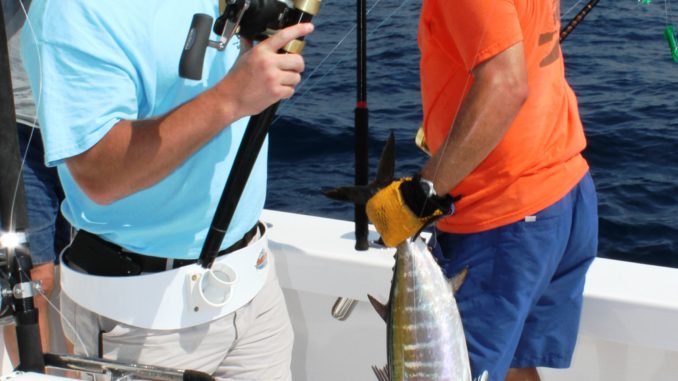
Blackfin tuna, dolphin and wahoo are regular guests on offshore boats
A mixed bag awaits South Carolina anglers heading to the Gulf Stream, and trolling is a good method of putting them in the boat. Blackfin tuna, dolphin and wahoo make up the bulk of meat fish currently biting, and sailfish are mixed in with all three to give fishermen a challenging fight.
Capt. Gasper Marino of the 57-ft Wadmacallit has been catching all four species trolling along the Gulf Stream’s ledge between the Georgetown Hole and the 226 Hole. Marino and his first-mate, Cot Smith, have been trolling a spread of these ballyhoo, along with teaser rigs, to draw the fish into striking range.
“This time of year, the temperature is really stable throughout this area, so Capt. Marino watches his electronics to look for baitfish schooling, and we troll over them,” said Smith. “The wahoo, (dolphin), tuna, and sailfish are all after these same baitfish, so you might catch any one of them. And because these fish are schooling, getting one bite means another bite is highly likely. Multiple hookups occur frequently, and it’s not always the same species.
“Once we find schools of baitfish, we troll between (at) six and seven knots, cruising over the baitfish and watching for strikes, which are sometimes subtle bumps. Sometimes they just knock the ballyhoo out of the water. Sometimes we just see the fish on the surface checking out the bait. When that happens, we remove the rods from the rod holders and drop the bait back a little, giving the fish a little extra enticement,” Smith said. “The blackfin and wahoo will usually just take it hard, but the sailfish and (dolphin) will often just bat the bait around, trying to stun it before biting. Just give them a little more time and when you feel them, lift the rod. Don’t try to set it like you do while bass fishing.”
Smity and Marino put out inline teaser rigs on both sides of the boat, trolling them on the surface about 50 feet behind the stern. They also deploy an umbrella rig on the port side that runs a foot or so under the stern.
“None of these have hooks in them. They are all just to draw attention to our spread,” said Smith, who stages six other short boat rods paired with 50-class Shimano Tiagra reels. Spooled with 50-pound monofilament and featuring 80-pound leaders, they are finished off with 7/0 hooks attached by pin rig to a ballyhoo dressed with a sea witch. Lines are set at staggered lengths behind the boat.
While trolling, Marino and Smith also look for diving birds, a telltale sign of baitfish schooling. Marino will troll directly into that area, which often draws strikes. They also keep an eye out for any debris such as floating wood or patches of weeds, which are good targets to troll by, said Marino.




